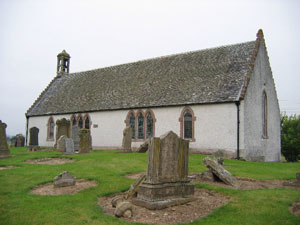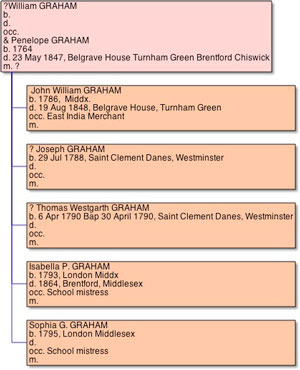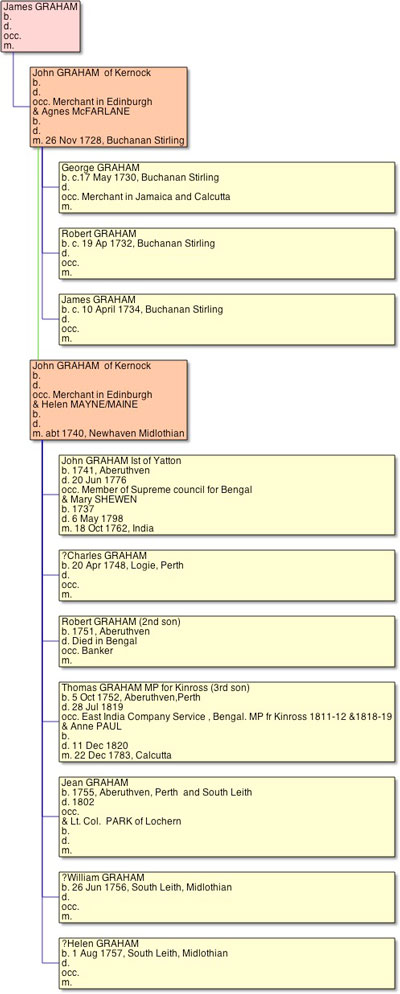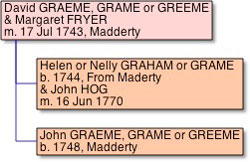
For the descendents of Richard Dearie and his son John Russell
Helen Graham or Nelly Grame from the Parish of Madderty, Perth.
Compiled by Claire Grey
Helen Graham married John Hog weaver on 16 June 1770, according to Perth parish registers.
The only information about her is that she came from the Parish of Madderty, which lies half way between Crieff and Perth. In the Parish registers of Madderty her name is spelled Nelly Grame.

The Parish registers of Madderty from 1538 to 1854 are all on line.
However there is only a Helen Greeme baptised there in 1744. If this is her it would make her 26 at the time of her marriage and 38 at the birth of her last child so this is possible.
The father of Helen is David Greeme. There is also a John Graeme born in 1748 whose father is David Graeme, who may or may not be the same person.
1703 is the first time any variant of the name Graham appears in the Madderty marriage registers and between then and 1840 there are 19 Graham marriages of various spellings recorded in Madderty parish. Of those who might be the parents of Helen there are about 5 possibilities. They include the marriage of a David Graeme to Margaret Fryer in 17 July 1743.
It is interesting that one of the names later given to the Hogg's children was "Freere" or "Frier" and it is possible that "Fryer" could have turned into "Freere" which was Oscar Hogg’s third name and Georgina Hogg's fourth name; otherwise David does not seem to be a name that the Hoggs reused.
There are only three burials of Graham as Grame recorded in the registers. Since there was no legal requirement to record these, this is not surprising. Of the three, two of them are with the spelling Grame and are about the time of Nelly’s marriage, John in 1766 and Mary in 1770. Both of these names are used in the Hogg family. Both of these people are said to be living at “Dubheads” and their names are written in larger lettering in the register as if they may have been of some note locally. In addition Mary Grame is said to have died in Edinburgh although she is interred at the church.
The 1770 will of John Graeme of Dubheads left his money to his daughter Emelia Graeme. No Emelia has been baptised at Madderty.
The family tree written by Annie Dearie describes Helen Graham's father as Sir John Graham, of Blackford and Redford, who was killed at Culloden, in 1746. If her father did support the Jacobites, he could have died at Cullodon, but it doesn't look as if he was a Sir, or called John.
When Nelly’s son John Hogg the jeweller died in 1839, the family who supported his wife and children were called Graham and can be found living with them in Turnham Green, London.
There is likely to be some connection between these Grahams and Nelly but at the moment it hasn't been made. Penelope, a governess, Isabella P., and Sophia G., school mistresses, and William, a retired East India Merchant, are all on the census for Turnham Green. Isabella's will has been found but makes no mention of any relatives.(2) William and his wife Penelope and their son John William are all buried at St. Nicolas churchyard Chiswick. Many of the gravestones there have been used for paving or are illegible due to erosion. So far they have not been found.
In addition two more possible children have been found on the family search web site: Joseph and Thomas but there may be no connection, and original sources have not yet been checked.


Left: Annie Dearie's family tree on the back of a photograph, shows Helen Graham descended from a Sir John Graham, killed at Culloden.
This now seems very unlikely.
The line drawn from Sir Graham Montgomery to Elizabeth Hogg is very tantalising, and what do the circles indicate?
Some speculations: The Kinross Connection.
Both Annie Dearie and her daughter Gertrude Fox record that they are descended from a Graham family connected to Kinross. The tree above contains a Basil Temple who may be Sir Basil Templer Graham-Montgomery, 5th Bt.
A note by Gertrude Fox attached to a news cutting about Montgomery reads:" Great grandmother Hogg: sister to Lady Helen Graham who married John Hogg married Montgomery.
For a family tree of the Kinross Grahams made from various secondary sources see right:(3)
This family did exist and is recorded in the Peerage online. Thomas Graham's daughter Helen married Sir James Montgomery of Stobo Castle in 1816 at St James Westminster. Their son was known as Sir Graham Montgomery, and his son was Sir Basil Templer Graham Montgomery.
If we assume that the William Graham of Kinross on Annie's tree above is the Thomas Graham of Kinross on the tree on the right the common ancestor would be John Graham of Kernock. But the children's names are not the same and Thomas' sister Helen is too old and born in the wrong place. " Ellen", "Annie" and "Elisabeth" on Annie's tree above are far more likely to be Hoggs and the sisters of John Hogg, jeweller, rather than Grahams; and to be the "old aunts" remembered by Georgina Hogg.(4) ( See below).
The common ancestor, if they exist, must be farther back. However Aberuthven is quite near Madderty.
WARNING None of this is verified from original sources. It may be (a) inaccurate, (b) have no connection with our family.

Further speculations: Bonny Dundee.
Family myth says that Sir John Graham was killed at Cullodon in 1746, and that he had had three daughters one of whom was Helen, who married John Hogg. Margaret and Annie were the other two in some versions of this story or as can be seen above William, Annie and Elisabeth. Sir John was attainted for following the Pretender and his title was confiscated and his furniture burnt in the streets of Edinburgh, or in other versions, his silver and furniture sold in the streets of Edinburgh. The story relates that George III was told of the distress of two sisters, and gave them a pension for their lives. In addition "Aunt Georgie remembers going to see these old Aunts".
Alfred Hogg was convinced that he was the heir to Graham of Claverhouse.
John Graham of Claverhouse, Viscount of Dundee (1649-89). Ardent supporter of the Stuart Cause, killed at the Battle of Killicrankie.
An article in the Argyll News on 25 July 2009 printed a list of attainders: the 118 people who had lost their lands for supporting the losing side. There are two Grahams: William Grahme of Duntroon in 1715 and James Graham late of Duntroon taking upon himself the title of Viscount of Dundee in 1745.
A contribution to Peerage News says this:" James Graham's uncle, David, third Viscount Dundee, was with his brother at the battle of Killiecrankie, and was in consequence outlawed in 1690, on which he retired to France. He died, without issue, in 1700, when the representation of the family devolved on David Graham of Duntroon, who died in January 1706. His son, William Graham of Duntroon, assumed the title of Viscount Dundee (wrongly), and engaging in the rebellion of 1715, was attainted and forfeited by act of parliament. The last of the family, James Graham of Duntroon, styling himself viscount of Dundee (wrongly), was forfeited for his adherence to the Pretender in 1746."
It may be that if there is any truth in our ancestor supporting the rebellion he may be connected to this family, possibly James. Or it may be that the Hoggs wanted to inhabit a romantic Walter Scott notion of Scottishness and made this up!
More speculation: Graham of Lyndoch
Another note by Gertrude Fox reads "Sir John Graham Redford Murray Graham of Lyndoch was Mama's Grandfathers cousin = Head of Branch Title confiscated after Culloden Field."
More about the Lyndoch Grahams can be read here.
They lived at Balgowan which is quite near Dubheads.
This branch is famous because of his wife's portrait by Thomas Gainsborough which was highly acclaimed when exhibited at the Royal Academy in 1777. The painting now hangs in the National Gallery of Scotland, Edinburgh.
Agnes Hogg believed she was connected to this family and was given a copy of the portrait by the sister of her employer Lady Cecil.
Even more Speculation: The Duke of Montrose
Notes by Gertrude Fox written in 1944 "Aunt Georgie when a girl remembered often riding with her father and his "cousin" the Duke of Montrose.The Dukes of Montrose were descendents of King Richard III of Scotland"
"Cousin" in the original is in quotation marks. James Ist Duke and 4th Marquis of Montrose was born in Glasgow in 1682 and died in London in 1742. His son William was born in Glasgow in 1712 and died in Twickenham London in 1790. He was buried in Aberuthven, Perthshire. The Montrose burial place was St Kattan's Chapel.
No research has connected them to our family.
Final speculation Illegitimacy
Robert Fox writing notes for his unwritten biography says: "The ... family descended directly from Graham of Claverhouse, and ..... I do remember her ( Annie) saying that her grandmother remembers her grandmother having an affair with her cousin the Duke of Montrose later executed in Edinburgh for plotting to put Charles II back on his father’s throne"
No evidence so far connects us to these titled and famous Grahams. A series of catastrophes seems to have occurred to any evidence that there once was. Alfred says the evidence of his being heir to Claverhouse was " lost in a wreck". The Godwins were supposed to have the family tree but it could not be found in Dolly's possessions after her death. On the back of a picture Gertude Fox wrote that the Legros family now at Windsor Castle might have the pedigree! ( This was grandchild of Georgina Rough nee Hogg.)
No conclusions can be drawn from this speculation. More research is needed to see if it is possible to connect the many family myths with the Madderty Grahams.
Left: A map marking some of the places associated with some of the Graham and Hogg families.
View Perth in a larger map
Notes:
(1) A rootsweb post, dated Sat, 21 Nov 1998: http://news.rootsweb.com/th/read/PERTHSHIRE/1998-11/0911651147
(2) Isabella's will is very hard to decipher. Here is a partial transcription: On the 31st day of May 1864 the Will of Isabella Penelope Graham late of Belgrave House Turnham Green in the County of Middlesex Spinster deceased, who died on the 18th day of May 1864 at Belgrave House aforesaid was proved in the Principal Registry of Her Majesty’s Court of Probate, by the Oath of John Steavenson of No. 19 Kings Arms Yard in the City of London Gentleman one of the Executors named in the said Will he having been first sworn duly to administer, Henry Rogers the other Executor named in the said Will having renounced the Probate and Execution thereof. Effects under £200 This is the last Will and Testament of me Isabella Penelope Graham of Belgrave House Turnham Green Spinster subject to the payment of all my just debts and funeral and testamentary expenses I give and bequeath unto John Steavonson of 19 Kings Arms Yard London Gentleman and Henry Rogers of 10 Hanover Square London Gentleman their executors administrators and assigns all my real and personal estate absolutely and I hereby appoint them my executors of this my will as witness my hand this 14th day of May 1864 – Isabella Penelope Graham – by ? William Forr….dale Vicar of Chiswick? The Vicarage Chiswick? Clerk in Holy Orders - ? and ? for the said Isabella Penelope Graham ??????/ for this ? Will and Testament in the presence of us being present at the same time who at her request in her presence and in the presence of each other have hereunto subscribed our names as witnesses - Mary Rebecca Henshaw Leathersellers ?? London Widow – Mary Ann Field Belgrave House Turnham Green Spinster.
On Her majesty’s Court of Probate The Principal Registry On the Goods of Isabella Penelope Graham deceased."
(3) A book about the Grahams called "Or and Sable" can be read online. Some of the information in it contradicts information from other sources.
(4) Scottish naming traditions in the 1800s are useful in trying to work out family connections.
MALES
Eldest son - named after his paternal grandfather
Second son - after his maternal grandfather
Third son - after his father
Fourth son - after his father's eldest brother
FEMALES
Eldest daughter - after her maternal grandmother
Second daughter - after her paternal grandmother
Third daughter - after her mother
Fourth daughter - after her mother's eldest sister

